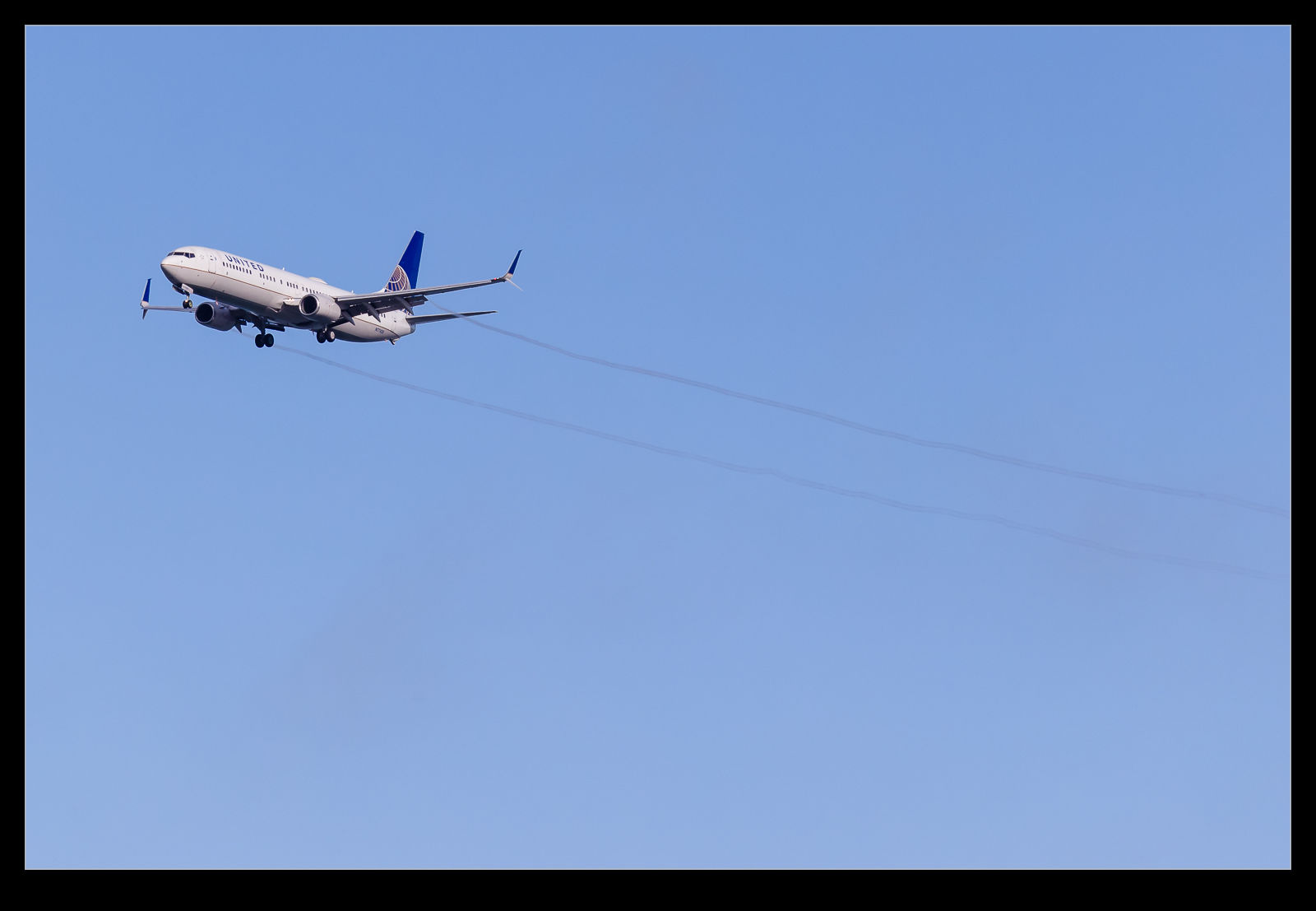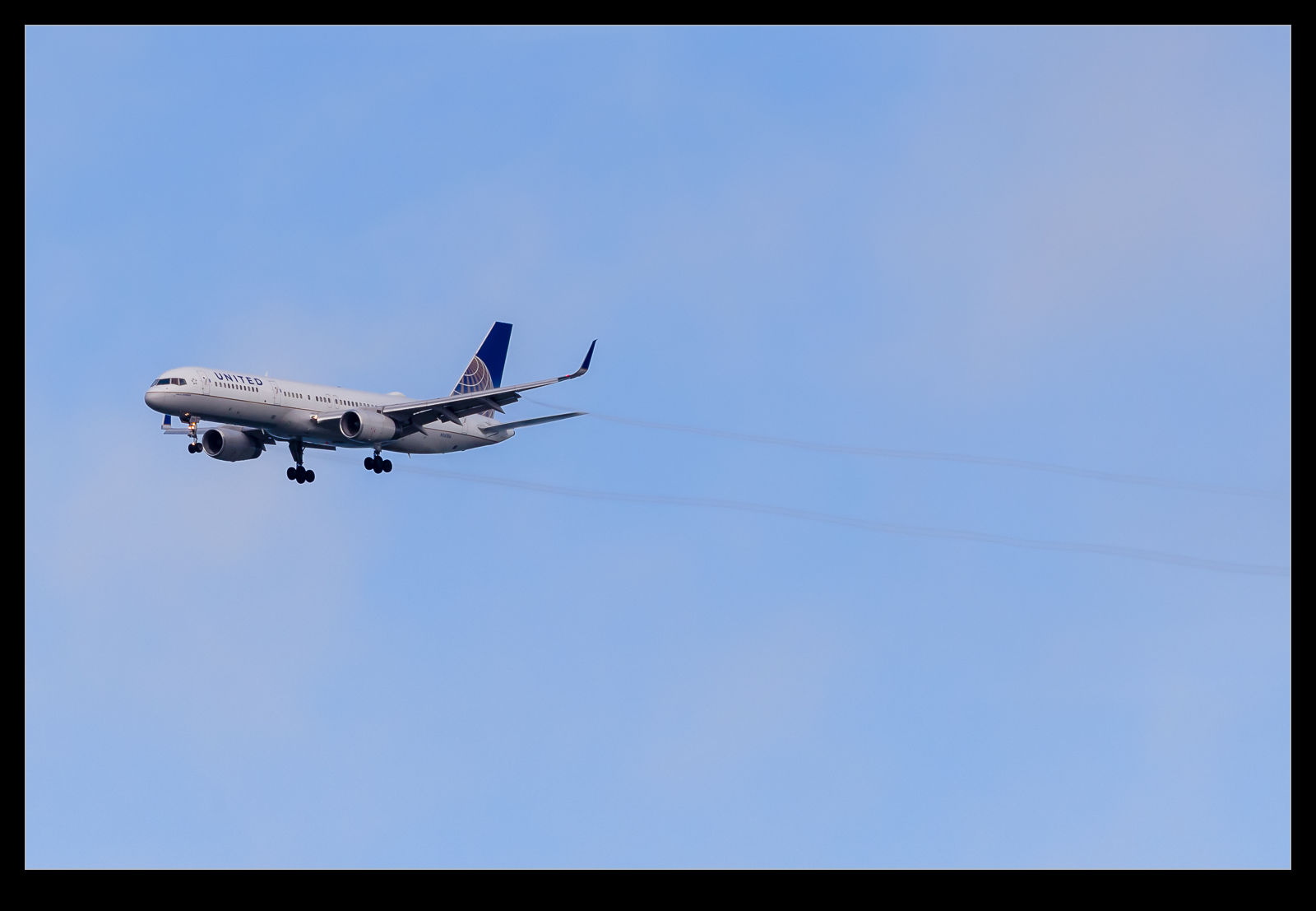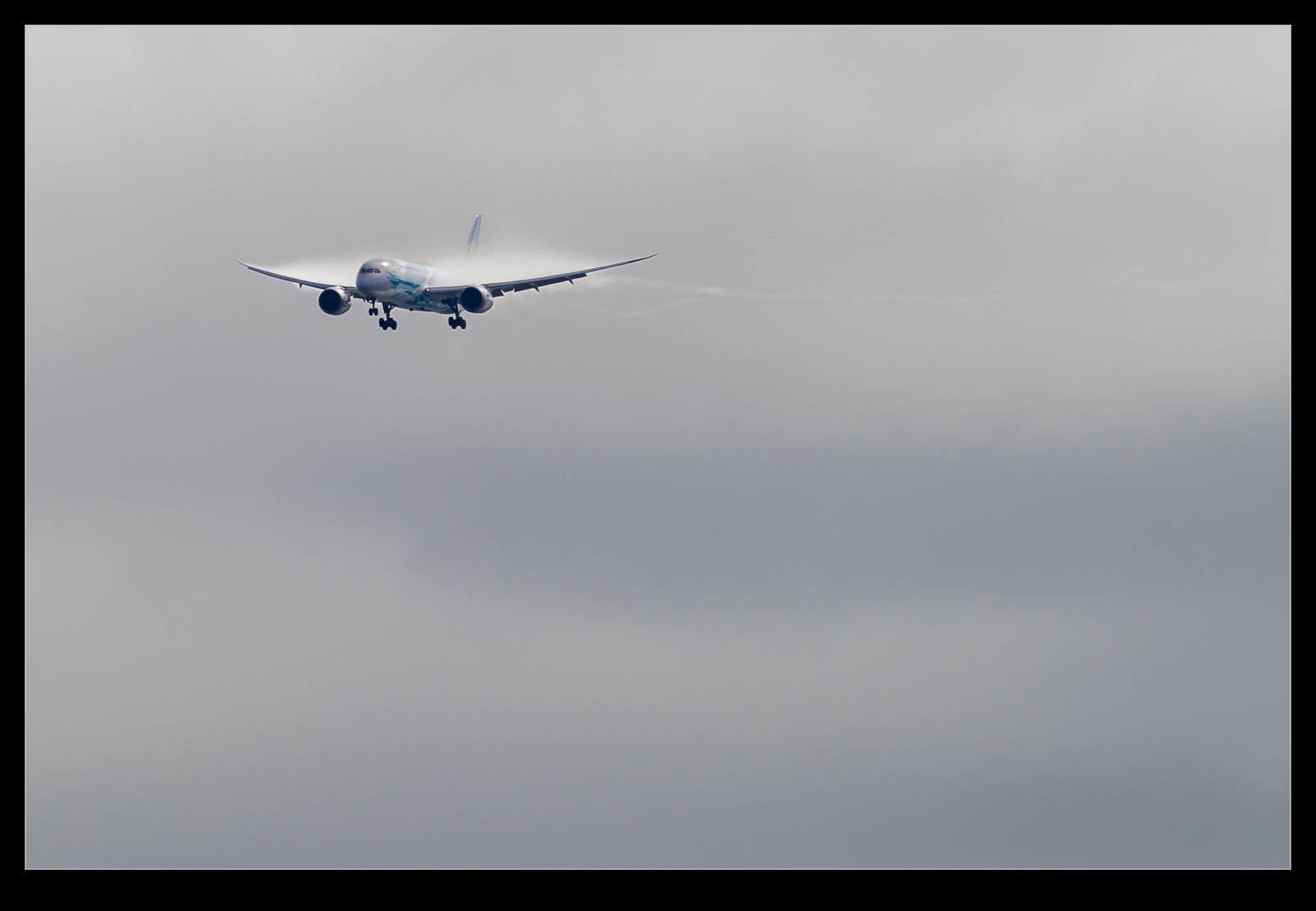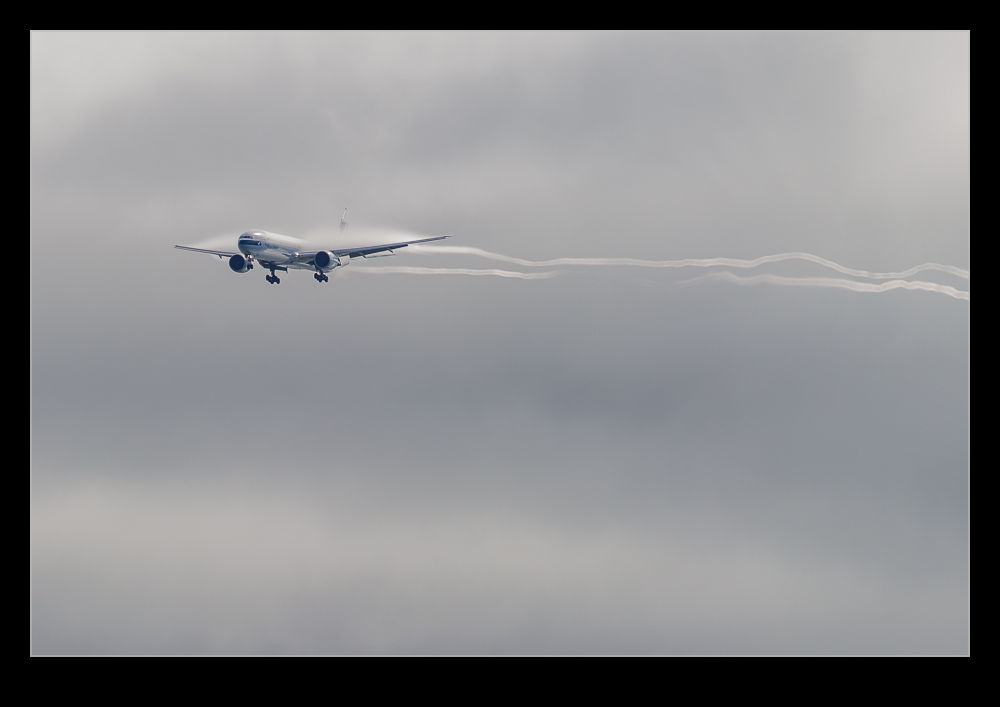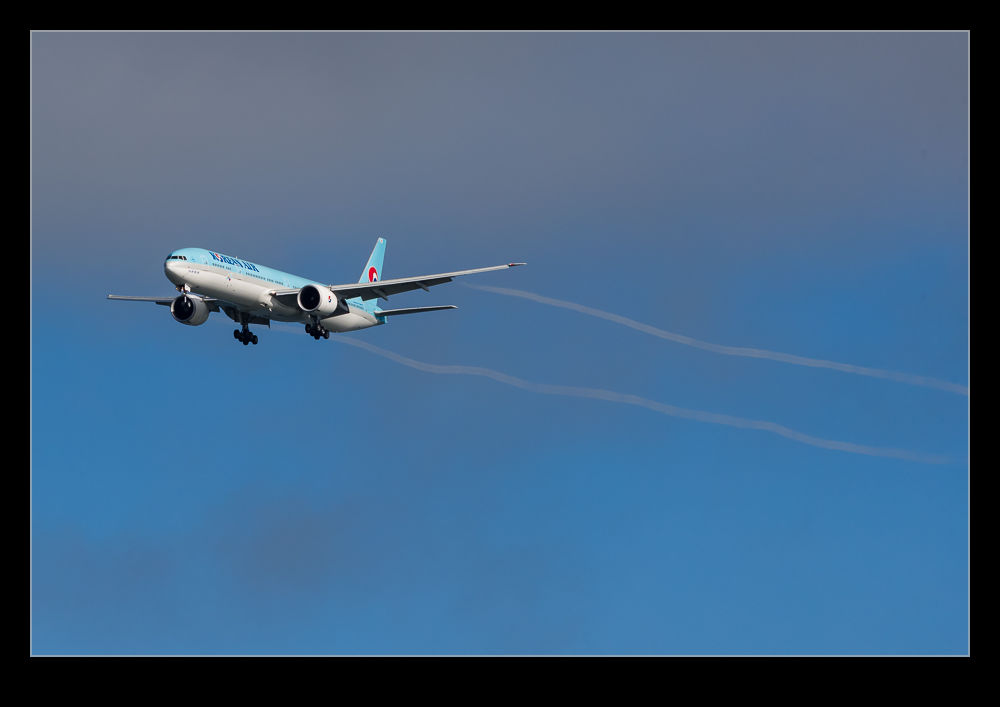 San Francisco Bay tends to provide a bit of moisture in the air that shows up as vapor clouds in the trailing vortices of approaching airliners. Before the planes reach Coyote Point, they are often trailing these streamers but, as they get closer to the airport, something about the conditions must change as they do seem to peter out. However, on some occasions, the moisture content must have been higher as the streamers lasted longer.
San Francisco Bay tends to provide a bit of moisture in the air that shows up as vapor clouds in the trailing vortices of approaching airliners. Before the planes reach Coyote Point, they are often trailing these streamers but, as they get closer to the airport, something about the conditions must change as they do seem to peter out. However, on some occasions, the moisture content must have been higher as the streamers lasted longer.
Tag Archives: trailing
Trailing Static Cones
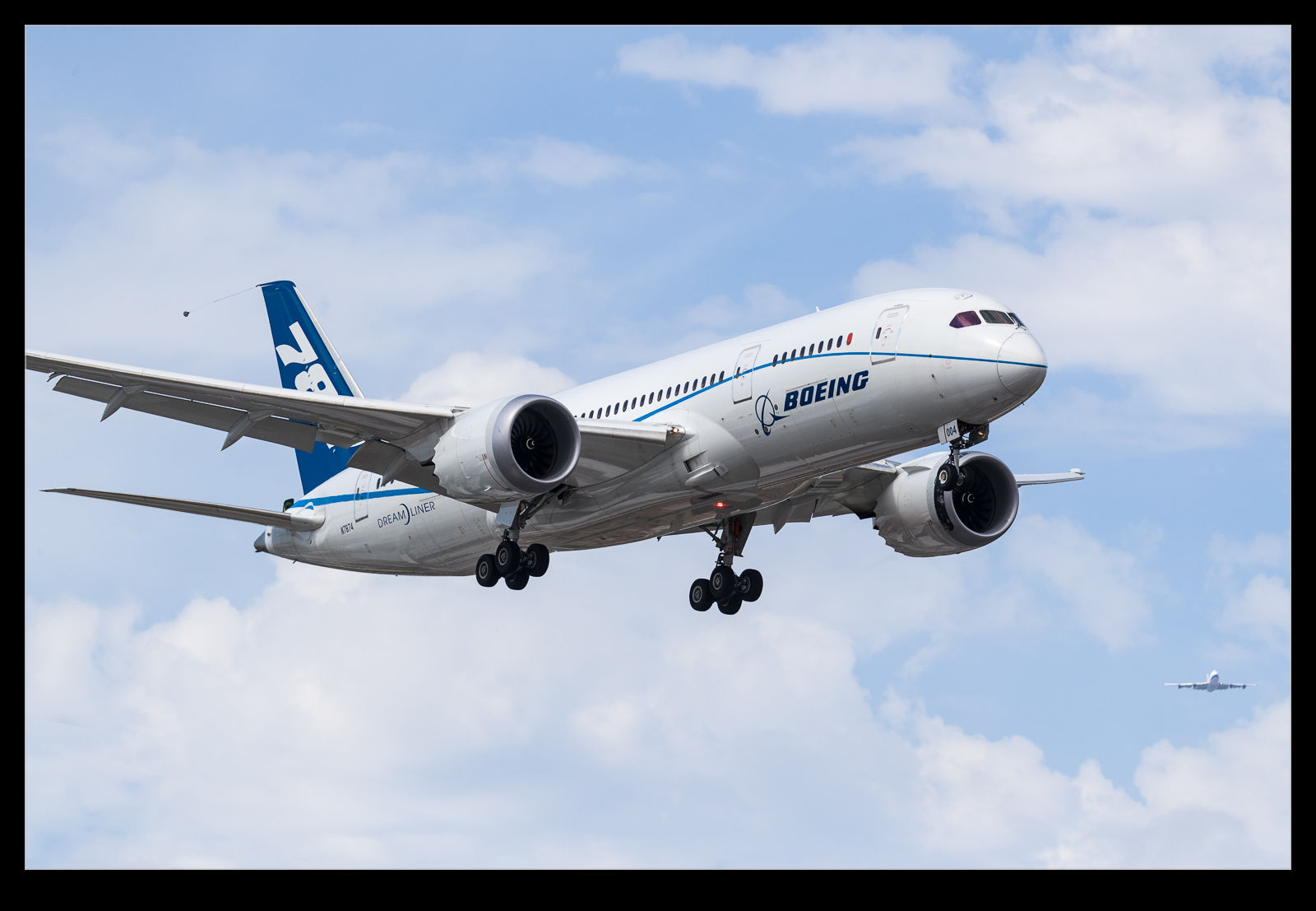 For the people that don’t care for my aviation posts, this one won’t be of interest. For the aviation fans that don’t care about the techie stuff, this will also be of limited interest. That probably leaves a very small group of readers by now (Gary, I am trusting you are still here). This is about a piece of flight test instrumentation that often causes questions when people see it. It is the trailing static cone.
For the people that don’t care for my aviation posts, this one won’t be of interest. For the aviation fans that don’t care about the techie stuff, this will also be of limited interest. That probably leaves a very small group of readers by now (Gary, I am trusting you are still here). This is about a piece of flight test instrumentation that often causes questions when people see it. It is the trailing static cone.
 The aircraft has sensors that measure air data, two of the most important of which are the pitot probe and the static port. The pitot probe measures the dynamic pressure of the air which increases as the speed increases. The static port measures the air around the aircraft. The difference between the two is used to determine the speed of the aircraft and the static is used to determine the altitude. These are both vital information for a pilot. However, the aircraft affects the flow of the air around it so, while you can calculate what the pressures should be, you need to validate what the actual readings are. The first flights are carried out prior to calibrating the system so you need to have a bit of margin in the speeds you use until you have confidence in the readings.
The aircraft has sensors that measure air data, two of the most important of which are the pitot probe and the static port. The pitot probe measures the dynamic pressure of the air which increases as the speed increases. The static port measures the air around the aircraft. The difference between the two is used to determine the speed of the aircraft and the static is used to determine the altitude. These are both vital information for a pilot. However, the aircraft affects the flow of the air around it so, while you can calculate what the pressures should be, you need to validate what the actual readings are. The first flights are carried out prior to calibrating the system so you need to have a bit of margin in the speeds you use until you have confidence in the readings.
 Measuring static pressure is hard to do. The plane will have a static port on the skin of the plane as well as possibly incorporated with the pitot head. However, the air has accelerated to go around the fuselage so it is assumed to have a lower pressure than ambient. Because the plane is disturbing the flow, you need a way to measure the pressure some distance away from the plane. The answer is a trailing static cone.
Measuring static pressure is hard to do. The plane will have a static port on the skin of the plane as well as possibly incorporated with the pitot head. However, the air has accelerated to go around the fuselage so it is assumed to have a lower pressure than ambient. Because the plane is disturbing the flow, you need a way to measure the pressure some distance away from the plane. The answer is a trailing static cone.
 This cone incorporates pressure measurement sensors and it attached to a long cable. This is held on a reel inside the aircraft and fed out of the aircraft at the rear. For airliners, this is usually through a modification to the top of the fin. A comparison between the test aircraft and a production jet will show the different structure. The cable dangles out of the fin and, as the speed increases, the cone pulls the cable taught and streams backwards.
This cone incorporates pressure measurement sensors and it attached to a long cable. This is held on a reel inside the aircraft and fed out of the aircraft at the rear. For airliners, this is usually through a modification to the top of the fin. A comparison between the test aircraft and a production jet will show the different structure. The cable dangles out of the fin and, as the speed increases, the cone pulls the cable taught and streams backwards.
 When the testing is required, the cable is winched out and the cone is a long way behind the aircraft in what is relatively undisturbed airflow. If you go to the Museum of Flight, the prototype 747 is on display and it includes the trailing cone equipment in the fuselage. The reel is shown in its mounting location and the trailing cone is hung inside to allow you to take a look at it.
When the testing is required, the cable is winched out and the cone is a long way behind the aircraft in what is relatively undisturbed airflow. If you go to the Museum of Flight, the prototype 747 is on display and it includes the trailing cone equipment in the fuselage. The reel is shown in its mounting location and the trailing cone is hung inside to allow you to take a look at it.
If You Want Shocks, You Don’t Need Fast Jets
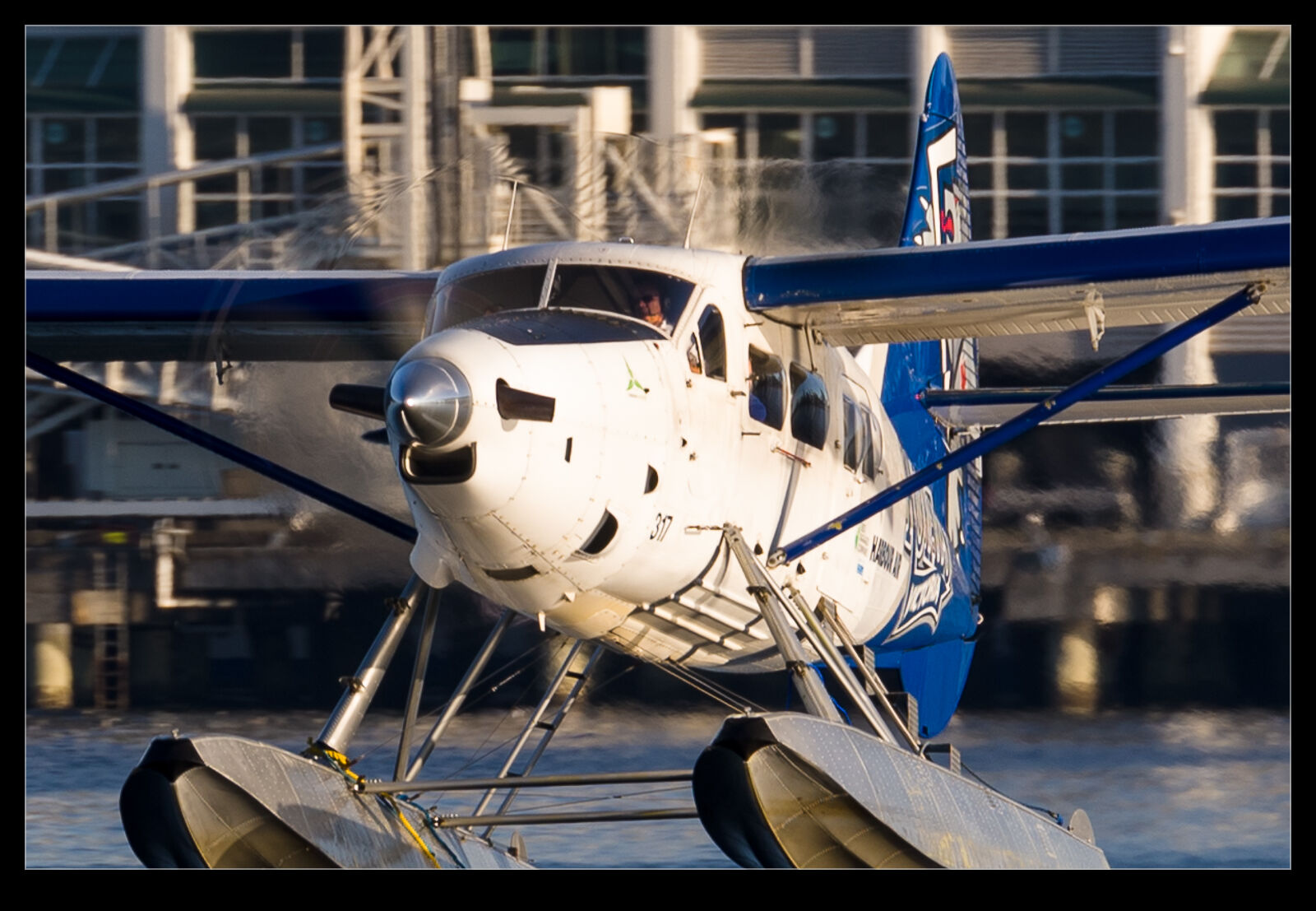 Every once in a while, when photographing a fast jet at transonic speeds, you might get something in the background that allows the diffraction caused by the formation of shockwaves to be visualized. I have posted about that here. I was in Vancouver and shooting the floatplanes taking off from the harbor (since it is a Canadian harbor, perhaps I should write harbour). As I was looking through the images zoomed in to check on sharpness, I realized that there was a visual effect of a similar nature. (If you think this is a Schlieren effect, it is not. That is a technique that involves a certain type of lighting to show the density differences but should not be applied to every time you see it in the wild.)
Every once in a while, when photographing a fast jet at transonic speeds, you might get something in the background that allows the diffraction caused by the formation of shockwaves to be visualized. I have posted about that here. I was in Vancouver and shooting the floatplanes taking off from the harbor (since it is a Canadian harbor, perhaps I should write harbour). As I was looking through the images zoomed in to check on sharpness, I realized that there was a visual effect of a similar nature. (If you think this is a Schlieren effect, it is not. That is a technique that involves a certain type of lighting to show the density differences but should not be applied to every time you see it in the wild.)
I don’t know whether what is showing up is the result of shocks forming on the props as they spin rapidly or just the tip vortices causing a similar effect. You can often see diffraction in trailing vortices. Whatever the reason, as you look above the aircraft at the patterns of structures on the shoreline beyond, you can clearly see some interesting effects. Since the props are spinning fast and there is an overlap of the wakes from each pass of a blade, the shapes are rather complex. Now I know that this is a thing, I might be tempted to take a longer lens and see what I can get in more detail of this interesting visual effect.
Humid Approaches to SFO
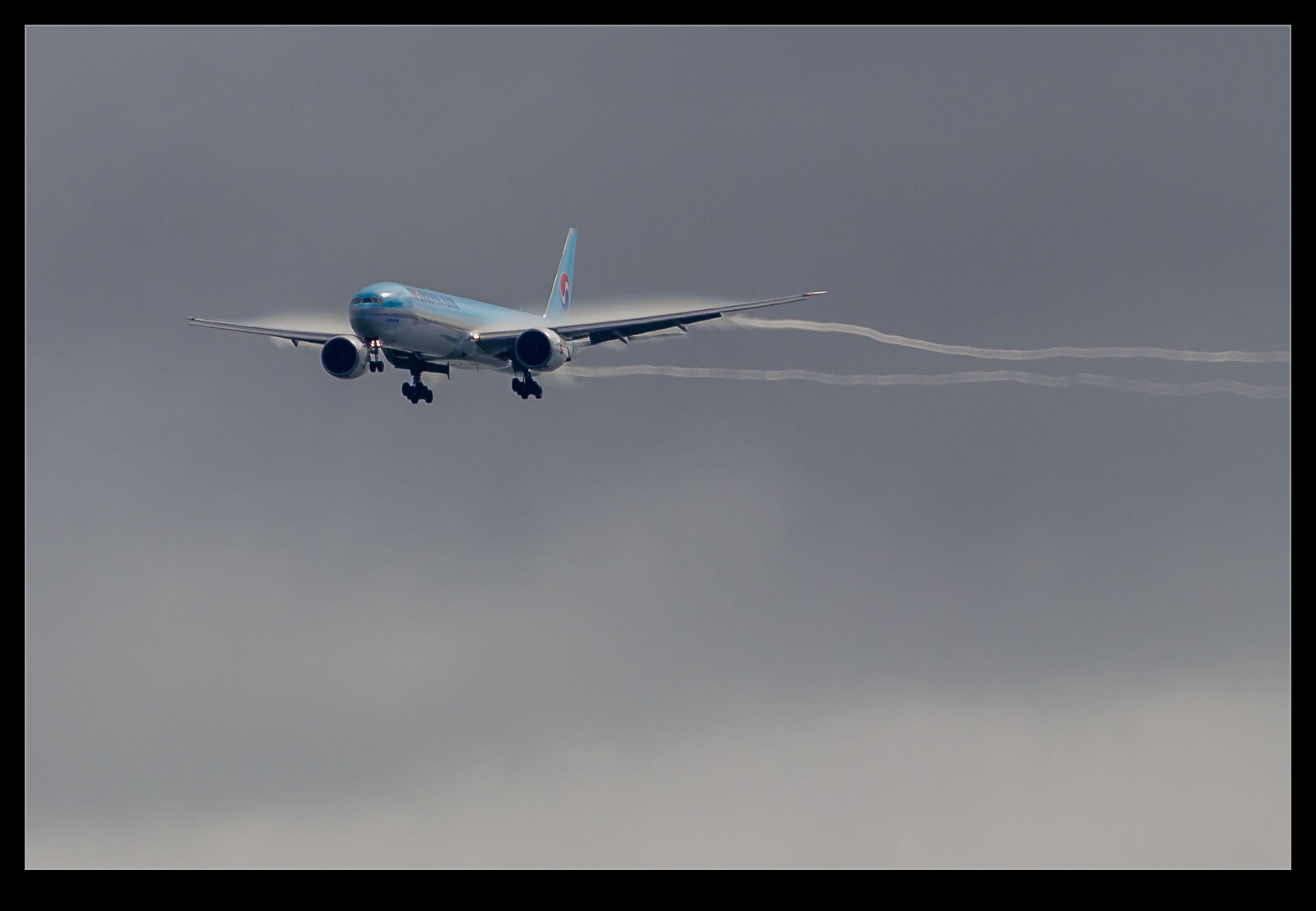 Moisture in the air is not always what you want when you are out shooting aircraft. However, it does have its benefits if there isn’t so much of it that everything is either obscured or gray. The weather conditions over San Francisco Bay can be very localized and, as the planes come down final approach, they can go through quite a variety. I was out hunting for Air Force One a while back and I got some good examples of this.
Moisture in the air is not always what you want when you are out shooting aircraft. However, it does have its benefits if there isn’t so much of it that everything is either obscured or gray. The weather conditions over San Francisco Bay can be very localized and, as the planes come down final approach, they can go through quite a variety. I was out hunting for Air Force One a while back and I got some good examples of this.
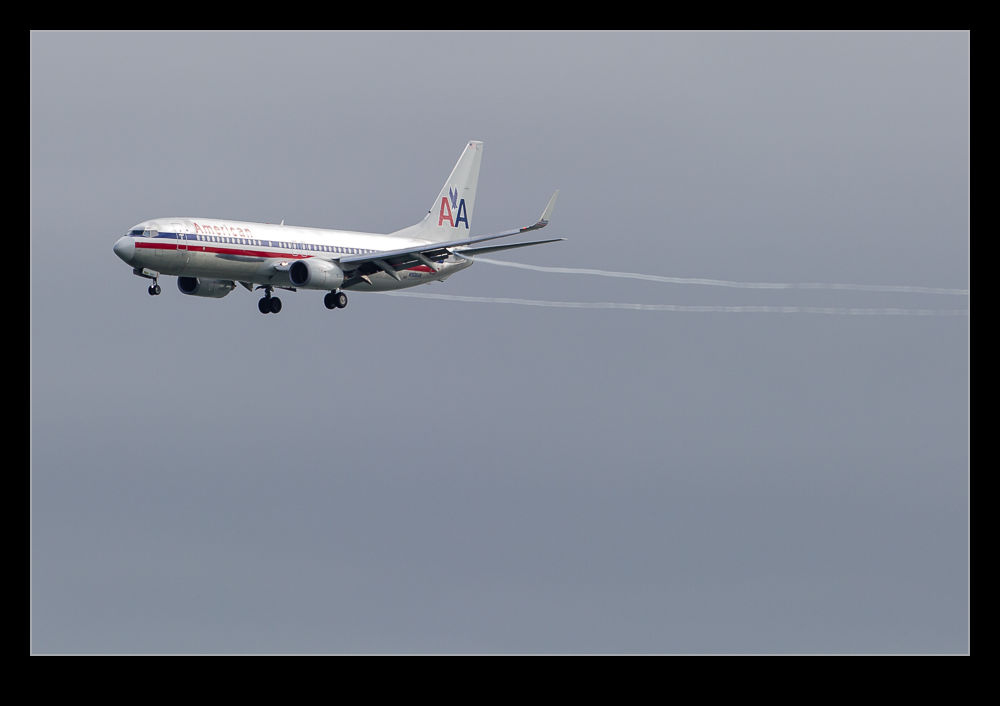 The weather at SFO was actually quite nice (although not when Air Force one departed as I have previously written about). The sun was out and the sky was pretty clear. In fact, there was quite a troubling amount of heat haze. However, once you got towards the south end of the bay, there was pretty solid cloud cover. The planes coming in were in full IMC for a good portion of their approach. Somewhere in the region between Coyote Point and the San Mateo Bridge they would break out of the cloud cover. Then, for the next mile or so, they were in the clear but still in very humid conditions.
The weather at SFO was actually quite nice (although not when Air Force one departed as I have previously written about). The sun was out and the sky was pretty clear. In fact, there was quite a troubling amount of heat haze. However, once you got towards the south end of the bay, there was pretty solid cloud cover. The planes coming in were in full IMC for a good portion of their approach. Somewhere in the region between Coyote Point and the San Mateo Bridge they would break out of the cloud cover. Then, for the next mile or so, they were in the clear but still in very humid conditions.
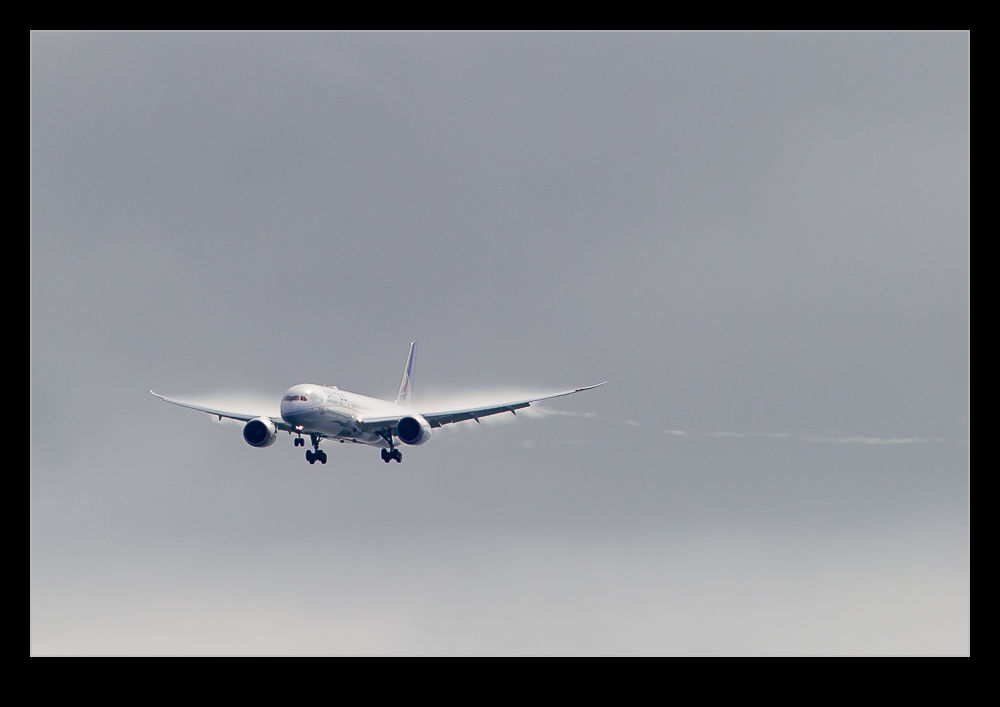 The result of this humidity was a lot of vapor forming up over the wings. The low speed and high lift configuration made the wings a good place to get cloud formations as the moist air passed over them. Additionally, the trailing vortices were showing up well as a result of the condensing moisture in them too. For quite a while, each aircraft showed similar patterns as it descended. The widebodies seemed to be better for showing this but that might just be a function of them being easier to see further away when the effect was most pronounced. The closer they got to the field, the less the effect until it was pretty much gone when they were on final approach.
The result of this humidity was a lot of vapor forming up over the wings. The low speed and high lift configuration made the wings a good place to get cloud formations as the moist air passed over them. Additionally, the trailing vortices were showing up well as a result of the condensing moisture in them too. For quite a while, each aircraft showed similar patterns as it descended. The widebodies seemed to be better for showing this but that might just be a function of them being easier to see further away when the effect was most pronounced. The closer they got to the field, the less the effect until it was pretty much gone when they were on final approach.
